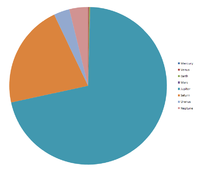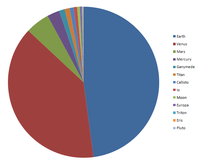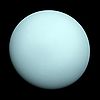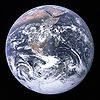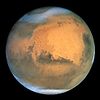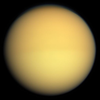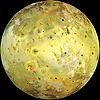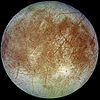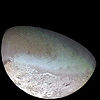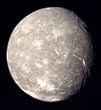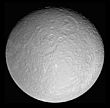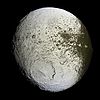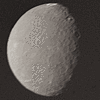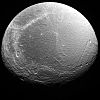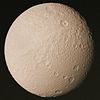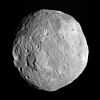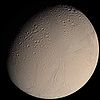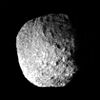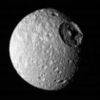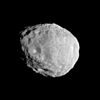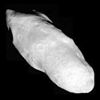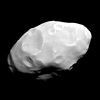- List of Solar System objects by size
-
Objects in the
Solar System- By orbit
- By size
- By discovery date
Categories This is a list of Solar System objects by size, arranged in descending order of mean volumetric radius. The list can also be partially sorted according to an object's mass and, for the largest objects, volume, density and surface gravity. This list contains the Sun, the planets, many of the larger small Solar System bodies (such as dwarf planets and asteroids), all named natural satellites, and a number of smaller objects of historical or scientific interest, such as comets and near-Earth objects.
The ordering may be different depending on whether one chooses radius or mass, because some objects are denser than others. For instance Uranus is bigger than Neptune but less massive, and although Ganymede and Titan are larger than Mercury, they have less than half its mass. This means some objects in the lower tables, despite their smaller radii, may be more massive than objects in the upper tables because they have a higher density.
Many trans-Neptunian objects (TNOs) have been discovered, and their approximate locations in this list are shown, even though there can be a large uncertainty in their measurement.
Solar System objects more massive than 1021 kilograms (one yottagram [Yg]) are known or expected to be approximately spherical. Astronomical bodies relax into rounded shapes (ellipsoids), achieving hydrostatic equilibrium, when the gravity of their mass is sufficient to overcome the structural strength of their material. These are dubbed "regular". Objects made of ice become regular more easily than those made of rock, and many icy objects are spheroidal at far lower sizes. The cutoff boundary for regularity is somewhere between 100 km and 200 km in radius.[1]
The larger objects in the mass range between 1018 kg to 1021 kg (1 to 1000 zettagrams (Zg)) such as Tethys, Ceres, and Mimas, have relaxed to an equilibrium oblate spheroid due to their gravity, while the less massive rubble piles (e.g. Amalthea and Janus) are roughly rounded, but not spherical, dubbed "irregular".
Spheroidal bodies typically have some polar flattening due to the centrifugal force from their rotation, but a characteristic feature of the "irregular"-shaped bodies is that there is a significant difference in the length of their two equatorial diameters.
There can be difficulty in figuring out the diameter (within a factor of about 2) for typical objects beyond Saturn. (See 2060 Chiron as an example.) For TNOs there is some confidence in the diameters, but for non-binary TNOs there is no real confidence in the "unreferenced wiki-assumed" masses/densities. Many TNOs are just assumed to have a density of 2.0 g/cm3, though it is just as likely that they have a comet-like density of only 0.5 g/cm3.[2] Thus most provisional TNOs are not given an MEarth value to prevent from cluttering the list with too many assumptions that could be off by an order of magnitude. For example, if a TNO is poorly assumed to have a mass of 3.59×1020 kg based on a radius of 350 km with a density of 2 g/cm3 and is later discovered to only have a radius of 175 km with a density of 1 g/cm3, the mass estimate would be only 2.24×1019 kg.
The sizes and masses of many of the moons of Jupiter and Saturn are fairly well known due to numerous observations and interactions of the Galileo and Cassini orbiters. But many of the moons with a radius less than ~100 km, such as Jupiter's Himalia, still have unknown masses with assumed densities.[3] Again, as we get further from the Sun than Saturn, things get less clear. There has not yet been an orbiter around Uranus or Neptune for long-term study of the moons. For the small outer irregular moons of Uranus, such as Sycorax, which were not discovered by the Voyager 2 flyby, even different NASA web pages, such as the National Space Science Data Center[4] and JPL Solar System Dynamics,[3] have somewhat contradictory size and albedo estimates depending on which research paper is being cited.
Data for objects has varying reliability including uncertainties in the figures for mass and radius, and irregularities in the shape and density, with accuracy often depending on how close it is to Earth or if it has been visited by a probe.
List
Objects above ≈300 km in radius
Anything above this size is probably in "hydrostatic equilibrium", but some bodies near the end of this list may not. However, their predicted or measured size would need to be "grossly in error" or their composition primarily rocky, for them not to be.[5] A lot of the values are manually calculated assuming sphericity. Size may or may not include an object's atmosphere. The diameter of Saturn's rings is around 364,900 km, much wider than Jupiter, but its gaseous sphere is smaller.
Body Image Mean radius
(km)Mean radius
(R⊕)Volume
(109 km3)Volume
(V⊕)Mass
×1021 kg
(Yg)Mass
(M⊕)Density[6]
g/cm3Surface gravity
(m/s2)Surface gravity
(⊕)Type of object Shape Sun 
696,000 109.25 1,412,000,000 1,303,781 1,989,100,000 332,837 1.409 274.0 28.02 Star regular Jupiter 
69,911 10.97 1,431,280 1,321 1,898,600 317.83 1.33 24.79 2.535 Planet regular Saturn 
58,232
(w/o rings)9.14 827,130 764 568,460 95.159 0.70 10.445 1.06 Planet regular Uranus 
25,362 3.98 68,340 63.1 86,832 14.536 1.30 8.87 0.90 Planet regular Neptune 
24,622 3.86 62,540 57.7 102,430 17.147 1.76 11.15 1.140 Planet regular Earth 
6,371.0 1 1,083.21 1 5,973.6 1 5.515 9.78033 1 Planet regular Venus 
6,051.8
(w/o gas)0.950 928.43 0.857 4,868.5 0.815 5.24 8.872 0.91 Planet regular Mars 
3,390.0 0.532 163.18 0.151 641.85 0.107 3.94 3.7 0.38 Planet regular Ganymede†
Jupiter III
2,631.2 0.413 76.30 0.0704 148.2 0.0248 1.936 1.428 0.15 Satellite of Jupiter regular Titan†
Saturn VI
2,576[7]
(w/o gas)0.404 71.52 0.0660 134.5 0.0225 1.88 1.354 0.14 Satellite of Saturn regular Mercury 
2,439.7 0.383 60.83 0.0562 330.2 0.0553 5.43 3.7 0.38 Planet regular Callisto†
Jupiter IV
2,410.3 0.378 58.65 0.0541 107.6 0.018 1.83 1.23603 0.126 Satellite of Jupiter regular Io†
Jupiter I
1,821.5 0.286 25.32 0.0234 89.3 0.015 3.528 1.797 0.183 Satellite of Jupiter regular Moon 
1,737.1 0.273 21.958 0.0203 73.5 0.0123 3.3464 1.625 0.166 Satellite of Earth regular Europa†
Jupiter II
1,561 0.245 15.93 0.0147 48 0.00803 3.01 1.316 0.134 Satellite of Jupiter regular Triton†
Neptune I
1,353.4 0.212 10.38 0.0096 21.5 0.00359 2.061 0.782 0.0797 Satellite of Neptune regular ErisR
136199
1,163[8] 0.182 7 0.007 16.7[9] 0.0027 2.25 0.662 0.0677 Dwarf planet — SDO — binary regular PlutoR
134340
1,161[10]
(w/o gas)0.181 7.15 0.0066 13.105 0.0022 2.0 0.61 0.062 Dwarf planet —
KBOregular Titania‡
Uranus III
788.9 0.124 2.06 0.0019 3.526 0.00059 1.72 0.378 0.0385 Satellite of Uranus regular Rhea‡
Saturn V
764.1[11] 0.12 1.87 0.0017 2.3166 0.00039 1.23 0.26 0.027 Satellite of Saturn regular Oberon†
Uranus IV
761.4 0.12 1.85 0.0017 3.014 0.0005 1.63 0.347 0.035 Satellite of Uranus regular Iapetus†
Saturn VIII
735.6[12] 0.113 1.55 0.0014 1.9739 0.00033 1.08 0.223 0.0227 Satellite of Saturn regular MakemakeRA
136472
710[13] 0.126
–0.1571.8 0.002 3 0.00067 2.0 0.4 0.04 Dwarf planet —
KBOregular Charon†
Pluto I603.5[14] 0.095 0.87 0.0008 1.52 0.00025 1.65 0.279 0.028 Satellite of Pluto regular SednaRA
90377
600–800[15] 0.09
–0.141.73 0.0016 3 0.00050 2.0 0.33
–0.500.0337
–0.0511Detached object unknown 2007 OR10
225088
"Snow White"
≈600[16]–710[5] 0.094 0.904 0.0008 1.81P 0.0003 2.0P 0.168 0.017 SDO unknown Umbriel†
Uranus II
584.7 0.092 0.84 0.0008 1.2 0.00020 1.4 0.234 0.024 Satellite of Uranus regular Ariel ‡
Uranus I
578.9 0.091 0.81 0.0008 1.35 0.00022 1.67 0.269 0.027 Satellite of Uranus regular HaumeaR
136108
575[17]–750[5] 0.117 1.3–1.6 0.001 4.006 0.00069 2.551[18] 0.44 0.045 Dwarf planet —
KBO — trinaryregular (scalene ellipsoid) Dione†
Saturn IV
561.6 0.088 0.73 0.0007 1.096 0.000183 1.48 0.232 0.0236 Satellite of Saturn regular Tethys‡
Saturn III
533 0.083 0.624 0.0006 0.6173 0.000103 1.15 0.145 0.015 Satellite of Saturn regular Ceres‡
1
475 0.076 0.437 0.0004 0.95 0.000159 2.08 0.27 0.0275 Dwarf planet — Asteroid regular Quaoar
50000
445[19] 0.07 0.37 0.0003 1.6[19] 0.0003 4.2[19] 0.125 0.013 KBO — Cubewano — binary unknown OrcusRA
90482
425[13] 0.069
–0.080.4 0.0004 0.63A 0.0001 1.5 0.234 0.023 KBO — Plutino — binary unknown 2002 TC302R
84522410–570[20] 0.09 0.786 0.0007 1.573P 0.00026 2.0 0.321 0.033 KBO — 2:5 resonance unknown 2007 UK1269
229762
375[5] 0.069 0.354 0.0003 0.708P 0.0001 2.0 0.246 0.025 SDO unknown 2005 UQ5139
202421375[5] 0.074 0.443 0.0004 0.886P 0.0001 2.0 0.278 0.0284 KBO — Cubewano unknown 2003 MW129
174567375[5] 0.0658 0.308 0.0003 0.616P 0.0001 2.0 0.228 0.02 KBO unknown 2002 AW197R
55565
370[5] 0.0576 0.207 0.00019 0.414P 0.000069 2.0 0.206 0.0211 KBO[21] unknown 2005 QU1829
303775365[5] 0.082 0.606 0.00056 1.21P 0.0002 2.0 0.294 0.03 SDO[22] unknown 2002 MS4 360[5]R 0.057 0.203 0.00018 0.4005P 0.000067 2.0P 0.204 0.02086 KBO[21] unknown 2007 JJ43
278361350[5] TNO[21] unknown 2003 AZ84R
208996345[5] 0.0538 0.169 0.000156 0.53P 5.66 E-5 2.0P 0.172 0.02 KBO — Plutino — binary unknown 2010 EK139 340[5] SDO unknown 2002 UX25R
55637
340[5] 0.0535 0.166 0.000153 0.331P 0.0000554 2.0 0.191 0.01952 KBO — binary unknown 2004 GV9R
90568340[5] 0.0531 0.162 0.00015 0.325P 0.0000534 2.0 0.19 0.0194 KBO unknown 2006 QH1819 340[5] 0.06 0.233 0.000215 0.467P 0.00008 2.0 0.214 0.022 SDO unknown 2005 RN439
145452330[5] 0.0573 0.2036 0.00019 0.407P 0.000068 2.0 0.205 0.02096 KBO[21] unknown 2010 KZ39 330[5] Detached object[23] or Cubewano[24] unknown IxionRA
28978
325[5] 0.051 0.144 0.000133 0.3 5.0E-5 2.086 0.19 0.021 KBO unknown 2004 XA192
230965320[5] 0.055 0.177 0.00016 0.354P 0.000059 2.0 0.195 0.02 TNO[21] unknown 2003 VS2
84922
315[5] 0.057 0.203 0.00018 0.4005P 0.000067 2.0 0.204 0.02086 KBO — Plutino[21] unknown 2001 UR1639
42301305[5] 0.05 0.134 0.00012 0.269P 0.000045 2.0P 0.178 0.018 SDO[21] unknown Salacia
120347305[5] 0.0455 0.102 0.00009 0.2P 0.000034 2.0P 0.159 0.016 KBO — binary unknown 2010 RE64 305[5] KBO unknown SDO unknown KBO — Plutino unknown 2003 UZ4139 300[5] 0.048 0.116 0.00012 0.33P 0.000055 2.0P 0.241 0.0246 KBO — Plutino unknown 2008 ST291 300[5] SDO unknown KBO — Cubewano unknown Selected objects between ≈300 and ≈200 km in radius
Satellites in this size range tend to be round (although Proteus is not), and TNOs are expected to be as well, assuming the estimated size is correct. The asteroid 10 Hygiea is not, and 2 Pallas and 4 Vesta are borderline.
Body Image Mean radius
(km)Mean radius
(R⊕)Volume
(109 km3)Volume
(V⊕)Mass
×1021 kg
(Yg)Mass
(M⊕)Density[25]
g/cm3Surface gravity
(m/s2)Surface gravity
(⊕)Type of object Shape Varuna*
20000
250[5] 0.049 0.125 0.000115 0.37 6.2E-5 0.992[18] 0.258 0.028 KBO unknown 2005 RM439
145451290[26] 0.0455 0.102 0.00009 0.2P 0.000034 2.0P 0.159 0.016 KBO unknown 2004 NT33 290[21] 0.043 0.089 0.000082 0.178P 0.000029 2.0P 0.155 0.0158 KBO — Cubewano[21] unknown 1996 TL66RA
15874287.5 0.045 0.1 9.2E-5 0.2 3.3E-5 2.009 0.162 0.018[5] SDO unknown 2004 UX10
144897284.5[5] 0.039 0.065 0.00006 0.13P 0.000022 2.0P 0.139 0.014 KBO unknown 2004 XR190
"Buffy"277[21]* 0.059 0.221 0.0002 0.4416P 0.00007 2.0P 0.21 0.0215 SDO[21] unknown 2004 TY364*
120348277[21] 0.043 0.089 0.000082 0.178P 0.000029 2.0P 0.155 0.0158 KBO[21] unknown HuyaR
38628266[20] 0.04175 0.0788 0.000073 0.158P 0.00026 2.0P 0.15 0.015 KBO — Plutino unknown Pallas$
2
266[27] 0.042 0.078 0.00007 0.211 0.0000353 2.8[28] 0.2 0.02 Asteroid uncertain Vesta$
4
264.6 0.042 0.078 0.00007 0.262 0.0000438 3.42[29] 0.251 0.0256 Asteroid regular? KBO unknown 2003 QX113 252.5[21] 0.036 0.051 0.00005 0.102P 0.000017 2.0P 0.129 0.013 SDO[21] unknown Enceladus‡
Saturn II
252.1 0.039 0.067 0.00006 0.108 0.0000181 1.61 0.111 0.0113 Satellite of Saturn regular 2006 HH123 239[5] 0.031 0.0335 0.000011 0.067P 0.000011 2.0 0.112 0.011 Centaur[21] unknown Miranda‡
Uranus V
235.8 0.037 0.055 0.00005 0.0659 0.000011 1.20 0.0791 0.00806 Satellite of Uranus regular 1999 DE9
26375230.5[20] 0.036 0.051 0.000047 0.1026P 0.000017 2.0 0.129 0.013 KBO unknown Chaos*
19521230–372.5[22] 0.0585 0.216 0.0002 0.4328P 0.00007 2.0P 0.209 0.021 KBO — Cubewano unknown 1998 SN165*
35671230[26] 0.036 0.05 0.000046 0.1P 0.000017 2.0 0.128 0.013 KBO unknown 2002 XV93 220[21] 0.036 0.051 0.00005 0.102P 0.000017 2.0 0.129 0.013 Plutino[21] unknown 2003 FY128*
120132220[21] 0.0345 0.0446 0.00004 0.089P 0.000014 2.0 0.123 0.0126 SDO[21] unknown 2000 YW134*
82075215.5[21] 0.039 0.065 0.00006 0.13P 0.000022 2.0P 0.139 0.014 SDO[21] unknown 1999 CD158 210[21] 0.0345 0.0446 0.00004 0.089P 0.000014 2.0 0.123 0.0126 KBO unknown Proteus ‡A
Neptune VIII (8)
210 0.033 0.038 0.000035 0.050 0.00000844 1.3[30] 0.0666 0.00678 Satellite of Neptune irregular 2001 QF298 210[21]* 0.04 0.067 0.00006 0.134P 0.000022 2.0 0.141 0.014 Plutino[21] unknown 10 Hygiea$ 203.6[31] 0.03 0.04 3.0E-5 0.0885 1.0E-5 2.5 0.143 0.02 Asteroid irregular 2002 WC19
119979200.5[32] 0.0315 0.034 0.00003 0.0675P 0.000011 2.0 0.113 0.0115 KBO — binary unknown 1996 GQ21*
26181200.5[21] 0.031 0.0335 0.000011 0.067P 0.000011 2.0 0.112 0.011 SDO[21] unknown Mimas‡
Saturn I
198.3 0.031 0.033 0.00003 0.03749 0.0000063 1.15 0.06363 0.00648 Satellite of Saturn regular Selected objects between 200 and 100 km in radius
Objects between 200 and 100 km in radius (400 and 200 km in diameter). The largest of these may lie above the boundary for hydrostatic equilibrium, but most are irregular. Most of the trans-Neptunian objects listed with a radius smaller than 200 km have "assumed sizes based on a generic albedo of 0.09" since they are too far away, with existing instruments, to directly measure their sizes. Values relative to Earth are not included beyond this point. Mass switches from 1021 kg to 1018 kg (Zg), with Mimas double listed as example of unit shift. Main-belt asteroids have orbital elements constrained by (2.0 AU < a < 3.2 AU; q > 1.666 AU) according to JPL Solar System Dynamics (JPLSSD).[33] This is not complete, missing many poorly known TNOs.[34]
Satellites of Jupiter Satellites of Saturn Satellites of Uranus Satellites of Neptune Body Image Mean radius
(km)Mass
×1018 kg
(Zg)Type of object Shape Mimas‡
Saturn I
198.3 37.49 Satellite of Saturn regular 2003 QW90 191.5[22] 89P Kuiper belt object unknown KBO unknown (15789) 1993 SC 181.5[22] Trans-Neptunian object — plutino[22] unknown (145480) 2005 TB190 186.25 [35] Detached object unknown (48639) 1995 TL8* 175 Kuiper belt object — binary unknown Nereid A
Neptune II170 31 Satellite of Neptune irregular 148780 Altjira 9 170[22] Trans-Neptunian object — cubewano unknown Trans-Neptunian object — plutino unknown 704 Interamnia M 158.31[36] 37 Main-belt asteroid — F-type unknown Hiʻiaka
Haumea I155 20 Satellite of Haumea unknown 1995 SN55* (lost) 155 Centaur unknown (79360) 1997 CS299 152.5[22] Kuiper belt object — binary unknown (79978) 1999 CC1589 152[22] Scattered-disc object unknown (40314) 1999 KR169 152 Trans-Neptunian object unknown 52 Europa$ 150.4 16.5 Main-belt asteroid — C-type irregular[37] 511 Davida$ 144.7 43.8 Main-belt asteroid — C-type irregular (55636) 2002 TX300 
143[38] 12 Kuiper belt object—Haumea family unknown (47171) 1999 TC36(A1) 143[39] Kuiper belt object — Trinary (A1+A2+B) unknown 87 Sylvia$ 142.8 14.78 Outer main-belt asteroid — X-type — trinary irregular[37] Vanth
Orcus I140–190 Satellite of Orcus unknown (26308) 1998 SM165 139.9[20] 14 Kuiper belt object — binary unknown 65 Cybele$ 136.5[40] 2004
118.7[41] IRAS17.8 Outer main-belt asteroid — C-type irregular Hyperion
Saturn VII135[3] 5.58 Satellite of Saturn irregular (47171) 1999 TC36(A2) 132.5[39] Kuiper belt object — Trinary (A1+A2+B) unknown 2005 PU219 132.5[22] Scattered-disc object unknown (79983) 1999 DF99 132.5 Trans-Neptunian object — cubewano unknown 107 Camilla$ 129.4 11.2 Outer main-belt asteroid — C-type — binary irregular[42] 10199 Chariklo 129.3 [20] Centaur unknown 31 EuphrosyneM 128 6.23 Main-belt asteroid — C-type unknown 15 Eunomia$ 127.7[43] 31.2 Main-belt asteroid — S-type irregular[37] (148209) 2000 CR105*A 126.5[44] 13 Detached object unknown (145453) 2005 RR43 126
348.4[44]Kuiper belt object—Haumea family unknown (119878) 2002 CY224 121[22] 15 Scattered disc object unknown 3 Juno $ 116.96[36] 26.7 Main-belt asteroid — S-type irregular[37] 2060 Chiron*A
95P/Chiron116.7 10 Centaur unknown 88 Thisbe $ 116[45] 10.5 M Main-belt asteroid — B-type irregular[42] (120178) 2003 OP32 115 Kuiper belt object — Haumea family unknown 2004 VN1129 115 Scattered-disc object unknown Kuiper belt object unknown 324 BambergaM 114 10 Main-belt asteroid — C-type unknown 451 Patientia 112.5 Main-belt asteroid unknown 19 Fortuna $ 112.5[47] 12.7 Main-belt asteroid — G-type unknown 532 Herculina 111 Main-belt asteroid — S-type irregular[37] 48 Doris 110.9[48] 17A Main-belt asteroid irregular 375 Ursula 108 [49] Main-belt asteroid unknown 45 EugeniaM 107 5.69 Main-belt asteroid — F-type — trinary irregular[37] Phoebe $
Saturn IX106.6 8.29 Satellite of Saturn irregular 29 Amphitrite$ 106 11.8 Main-belt asteroid — S-type irregular[37] 53311 Deucalion 105.5[22] Trans-Neptunian object — cubewano unknown (33001) 1997 CU29 105.5 Trans-Neptunian object — cubewano unknown 423 DiotimaA 104.385[36] 16 Main-belt asteroid — C-type irregular[50] (181902) 1999 RD215 104.33[22] Scattered disc object unknown 13 EgeriaM 103.82[36] 16.3 Main-belt asteroid — G-type unknown 54598 Bienor 103.5[51] Centaur unknown 94 Aurora 102.5 Main-belt asteroid irregular[52] 624 HektorA 101.5[53] 14 Asteroid — Jupiter Trojan — binary irregular 38083 Rhadamanthus 100.5[22] Kuiper belt object unknown (19308) 1996 TO66 100 Kuiper belt object — Haumea family unknown Selected objects between 100 and 50 km in radius
Objects 100 and 50 km in radius (200 km to 100 km in average diameter). This currently includes most objects in the asteroid belt and moons of the gas giants in this size range, but is missing many newly discovered objects in the outer Solar System such as here.[34] Asteroid spectral types are mostly Tholen, but some might be SMASS.
Body Image Mean radius
(km)Mass
×1018 kg
(Zg)Type of object 7 Iris$ 99.915 [54] 13.6 Main-belt asteroid — S-type 24 Themis M 99 11.3 Main-belt asteroid — C-type — Themis 702 Alauda 97.4[36] 6.05 Main-belt asteroid — C-type — binary LarissaA
Neptune VII (7)97 4.2 Satellite of Neptune (85633) 1998 KR65 96[22] Kuiper belt object — cubewano 121 HermioneM 95 5.38 Outer main-belt asteroid — C-type — binary Actaea
Salacia I95 Satellite of 120347 Salacia 372 Palma 94.31[55] Main-belt asteroid 128 Nemesis 94.1 7 Main-belt asteroid — C-type 16 Psyche$ 93.0 21.9 Main-belt asteroid — M-type 6 Hebe $ 92.59[36] 12.8 Main-belt asteroid — S-type 5145 Pholus 92.5[56] 6.6 Centaur 154 Bertha 92.47[36] 5.2 Main-belt asteroid — C-type 76 Freia 91.83 6.5 Outer main-belt asteroid — Cybele (59358) 1999 CL1589 91.5 Trans-Neptunian object — unstable 130 ElektraM 91.1[36] 6.6 Asteroid — G-type — binary (119951) 2002 KX14 90[21] Trans-Neptunian object[21] Janus$
Saturn X (10)89.4 1.912 Satellite of Saturn 259 Aletheia 89.3[36] 5.97 Main-belt asteroid Galatea
Neptune VI (6)88[3] 2.12 Satellite of Neptune 88611 Teharonhiawako 88[22] Trans-Neptunian object — cubewano — binary 42355 Typhon 87.5[20] Trans-Neptunian object — binary (19255) 1994 VK8 87.5[22] 5.6 Trans-Neptunian object — cubewano 120 Lachesis 87.05[36] 5.5 Main-belt asteroid 65489 Ceto 87[57] 5.4[57] Centaur — TNO — binary (24835) 1995 SM55 87 Kuiper belt object — Haumea family 41 Daphne 87 Main-belt asteroid 9 Metis$ 86.9 11.3 Main-belt asteroid 747 Winchester 85.86[36] Asteroid 153 Hilda 85.32[36] 5.2 Main-belt asteroid — Hildas 790 Pretoria 85.2[58] Outer main-belt asteroid — Cybele Himalia M
Jupiter VI (6)85[3]–92[59] 4.19 [60] Satellite of Jupiter — Himalia group Namaka
Haumea II85 2 Satellite of Haumea 96 Aegle 84.95 5.1 Main-belt asteroid 241 Germania 84.45[36] 5.05 Main-belt asteroid — C-type 194 Prokne 84.21[36] 5 Main-belt asteroid — C-type 566 Stereoskopia[61] 84.08[36] Outer main-belt asteroid — Cybele Amalthea
Jupiter V (5)83.5[62] 2.08[63] Satellite of Jupiter$ 911 Agamemnon 83.3[36] Asteroid — Jupiter Trojan 22 Kalliope 83.1[64] 8.09M Main-belt asteroid — M-type — binary 66652 Borasisi 83[22] Trans-Neptunian object — cubewano — binary 54 Alexandra 82.88 Main-belt asteroid 386 Siegena 82.5[65] Main-belt asteroid — C-type 59 Elpis 82.4 Main-belt asteroid 1437 Diomedes 82.16[36] 4.6 Asteroid — Jupiter Trojan 444 GyptisM 81.54[36] 12.5 Main-belt asteroid — C-type Puck
Uranus XV [15]81[3] 2.9A Satellite of Uranus 409 Aspasia 80.81[36] 4.42 Main-belt asteroid — C-type 20461 Dioretsa 80.2[22] Centaur[66] — Damocloid 1992 QB1 80[22] Kuiper belt object — cubewano (15875) 1996 TP66 80[20] Kuiper belt object — inner plutino 209 Dido 79.97[36] 4.28 Main-belt asteroid — C-type 334 Chicago 79.275[36] Main-belt asteroid — C-type 804 Hispania 78.79[36] 9.95 Main-belt asteroid — P-type 185 Eunike 78.76[36] 4.09 Main-belt asteroid 139 Juewa 78.3[36] 4 Main-belt asteroid 354 Eleonora 77.585[36] Main-belt asteroid — S-type 85 Io 77.4[67] 3.4 Main-belt asteroid 165 Loreley 77.39[36] 3.91 Main-belt asteroid — C-type 173 Ino 77.05[36] 3.83 Main-belt asteroid — C-type 11 Parthenope 76.67[36] 6.15M Main-belt asteroid (137295) 1999 RB216 76.5[22] Kuiper belt object — twotino 14 Irene 76[68] 8.2 Main-belt asteroid 89 Julia 75.75 3.6 Main-belt asteroid — S-type 536 Merapi 75.7[36] Main-belt asteroid (145474) 2005 SA278 75.62[22] Scattered-disc object 776 Berbericia 75.59[36] Main-belt asteroid 145 Adeona 75.57[36] 3.6 Main-belt asteroid — Adena 150 Nuwa 75.565[36] 3.62 Main-belt asteroid — C-type Dysnomia
Eris I75[69] Satellite of Eris DespinaA
Neptune V75 2.1 Satellite of Neptune Sycorax
Uranus XVII75[3] 2.3 Satellite of Uranus 49 Pales M 74.9[36] 2.69 Main-belt asteroid — C-type 39 Laetitia 74.75 3.5 Asteroid 117 Lomia 74.36[36] 3.4 Main-belt asteroid — C-type 238 Hypatia 74.245[36] Main-belt asteroid — C-type 168 Sibylla 74.195[36] 3.42 Main-belt asteroid — C-type 283 EmmaM 74 1.38 Asteroid — binary 51 Nemausa 73.93 Asteroid 106 Dione 73.3 Main-belt asteroid — G-type (118378) 1999 HT11 73[22] Trans-Neptunian object 137 Meliboea 72.71[36] 3.2 Main-belt asteroid 20 Massalia$ 72.5 5.67 Asteroid 211 Isolda 71.6[36] 3.07 Main-belt asteroid — C-type 1172 Äneas 71.41[70] Asteroid — Jupiter Trojan 144 Vibilia 71.19[36] 3 Main-belt asteroid 508 Princetonia 71.18[36][71] Main-belt asteroid 895 Helio 70.95 [36] Main-belt asteroid — B-type 361 Bononia 70.86 [36] Main-belt asteroid — D-type 420 Bertholda 70.625 [36] Main-belt asteroid — P-type 93 Minerva 70.5 2.9 Main-belt asteroid — C-type — trinary 617 Patroclus 70.46 [36] Asteroid — Jupiter Trojan — binary 308 Polyxo 70.345[36] 2.92 Main-belt asteroid — T-type 18 Melpomene 70.3 3 Main-belt asteroid 268 Adorea 69.945[36] 2.87 Main-belt asteroid 349 Dembowska 69.885[36] Main-belt asteroid — R-type 489 Comacina 69.695 [36] Main-belt asteroid (47171) 1999 TC36(B) 69.5[39] Kuiper belt object — Trinary (A1+A2+B) 69 Hesperia 69.07 2.76 Main-belt asteroid — M-type Kuiper belt object — Haumea family 762 Pulcova 68.54 [36] Main-belt asteroid — C-type — binary Pabu
Borasisi I68.5[72] Secondary of 66652 Borasisi 196 Philomela 68.195[36] 2.65 Main-belt asteroid — S-type 212 Medea 68.06[36] 2.64[73] Main-belt asteroid 95 Arethusa 68.02[36] 2.6 Main-belt asteroid Portia
Uranus XII67.6[3] 1.7 Satellite of Uranus 588 Achilles 67.735 [36] Asteroid — Jupiter Trojan 690 Wratislavia 67.325 [36] Asteroid 111 Ate 67.28 Main-belt asteroid — C-type 247 Eukrate 67.215[36] Main-belt asteroid — C-type 705 Erminia 67.11[36] Main-belt asteroid 471 Papagena 67.095 [36] Main-belt asteroid — C-type Phorcys
Ceto I67[22] 1.67[57] Satellite of 65489 Ceto 1998 WW31 66.5 2 Trans-Neptunian object — binary 147 Protogeneia 66.465[36] 2.5 Main-belt asteroid Menoetius
Patroclus I66.3 Secondary of 617 Patroclus 344 Desiderata 66.135[36] 2.42 Main-belt asteroid — C-type 146 Lucina 66.1[36] 2.4 Main-belt asteroid 141 Lumen 65.52[36] 1.6 Main-belt asteroid — C-type 356 Liguria 65.655 [36] Main-belt asteroid 187 Lamberta 65.2 [36] 2.37 Main-belt asteroid — C-type 419 Aurelia 64.505 [36] Main-belt asteroid — F-type 200 Dynamene 64.18[36] Main-belt asteroid 8 Flora 63.9 8.47 Main-belt asteroid — S-type — Flora 712 Boliviana 63.785 [36] Main-belt asteroid — X-type 654 Zelinda 63.7 [36] Main-belt asteroid 426 Hippo 63.55 [36] Main-belt asteroid 47 Aglaja pic 63.48 Main-belt asteroid — C-type 279 Thule 63.295[36] Main-belt asteroid — D-type 92 Undina 63.21[74] 2.1 Main-belt asteroid — M-type 1173 Anchises(1930 UB) 63.135[36] Asteroid — Jupiter Trojan 1143 Odysseus 62.82[36] Asteroid — Jupiter Trojan (L4) 469 Argentina 62.785 [36] Main-belt asteroid — Cybele 159 Aemilia 62.5 1.4 Asteroid 405 Thia 62.45 [36] Main-belt asteroid — C-type 602 Marianna 62.36 [36] Main-belt asteroid 46 Hestia 62.07[36] 3.5[75]–21[76] Main-belt asteroid 216 Kleopatra 
62 Main-belt asteroid — M-type — trinary 104 Klymene 61.9 2 Main-belt asteroid 410 Chloris 61.785 [36] Main-belt asteroid — C-type 134 Sophrosyne 61.64 2 Main-belt asteroid 328 Gudrun 61.46[36] 1.94 Main-belt asteroid — S-type 1867 Deiphobus 61.335[36] Asteroid — Jupiter Trojan 68 Leto 61.3 Main-belt asteroid — S-type 70 Panopaea 61.01 Main-belt asteroid — C-type Sawiskera
Teharonhiawako I61 Secondary of 88611 Teharonhiawako 127 Johanna 61[77] Main-belt asteroid 276 Adelheid 60.8[36] Main-belt asteroid 176 Iduna 60.52[36] 1.76 Main-belt asteroid — G-type 156 Xanthippe 60.495[36] 1.85 Main-belt asteroid — S-type 28 Bellona 60.45[36] Main-belt asteroid — C-type 86 Semele 60.3 Main-belt asteroid — C-type 78 Diana 60.3 Main-belt asteroid — C-type 381 Myrrha 60.29 [36] Main-belt asteroid — C-type — 225 Henrietta 60.245[36] 1.83 Main-belt asteroid — C-type — Cybele 618 Elfriede 60.145 [36] Main-belt asteroid — C-type — (73840) 2002 PN34 59.75[20] Scattered-disc object 105 Artemis 59.6 1.8 Main-belt asteroid — C-type 81 Terpsichore 59.54 Main-belt asteroid — C-type 5 Astraea 59.535[36] 2.9 Main-belt asteroid 74 Galatea 59.36 1.8 Main-belt asteroid — C-type 350 Ornamenta 59.175[36] Main-belt asteroid — C-type 772 Tanete 58.83[36] Main-belt asteroid — C-type 476 Hedwig 58.38 [36] Main-belt asteroid 1093 Freda 58.365 [36] Main-belt asteroid 171 Ophelia 58.35[36] 1.66 Main-belt asteroid — C-type — Themis 909 Ulla 58.22[36] Asteroid 3317 Paris 58.13[36] Asteroid — Jupiter Trojan 203 Pompeja 58.125[36] Main-belt asteroid 3063 Makhaon 58.07[36] 1.6 Asteroid — Jupiter Trojan 38 Leda 57.97[36] 1.6 Asteroid 360 Carlova 57.88[36] Main-belt asteroid — 521 Brixia 57.825 [36] Main-belt asteroid — 490 Veritas 57.775[36] Main-belt asteroid — Veritas 466 Tisiphone 57.765 [36] Main-belt asteroid — C-type 53 Kalypso 57.69 Asteroid 2241 Alcathous 57.315 [36] Asteroid — Jupiter Trojan 388 Charybdis 57.085 [36] Main-belt asteroid — C-type 34 Circe 56.75 1.5 Main-belt asteroid — C-type Epimetheus
Saturn XI (11)56.7[3] 0.5304[78] Satellite of Saturn$ 596 Scheila 56.67 [36] Main-belt asteroid 56 Melete 56.62 1.5 Asteroid 129 Antigone 56.5[79] 2 Main-belt asteroid — nickel-iron 12 Victoria 56.4 Main-belt asteroid — S-type 57 Mnemosyne 56.3 Asteroid 545 Messalina 55.645 [36] Asteroid 2797 Teucer 55.57[36] Asteroid — Jupiter Trojan(L4) 2920 Automedon 55.5[36] Asteroid — Jupiter Trojan(L4) 2001 QR322 55 Neptune trojan 91 Aegina 54.9 1.4 Main-belt asteroid — C-type 140 Siwa 54.895 [36] 1.4 Main-belt asteroid 814 Tauris 54.78[36] Main-belt asteroid 595 Polyxena 54.535 [36] Main-belt asteroid 230 Athamantis 54.495 Main-belt asteroid — S-type 659 Nestor 54.435 [36] Asteroid — Jupiter Trojan 37 Fides 54 1.3 Main-belt asteroid — S-type 514 Armida 53.085 [36] Main-belt asteroid 23 Thalia 53.8 1.3 Main-belt asteroid — S-type 739 Mandeville 53.765 [36] Main-belt asteroid — X-type 2007 VL305 A 53.75 Neptune trojan 40 Harmonia 53.6 1.3 Main-belt asteroid — S-type 181 Eucharis 53.33[36] 1.2 Main-belt asteroid — K-type 346 Hermentaria 53.26 [36] Main-belt asteroid — S-type 357 Ninina 53.05 [36] Main-belt asteroid 506 Marion 52.97 [36] Main-belt asteroid — C-type 365 Corduba 52.96 [36] Main-belt asteroid — C-type 36 Atalante 52.8 Asteroid 713 Luscinia 52.76 [36] Main-belt asteroid — C-type 1269 Rollandia 52.595[36] Main-belt asteroid 164 Eva 52.435[36] 1.21 Main-belt asteroid — C-type 98 Ianthe 52.25 1.2 Main-belt asteroid — C-type 240 Vanadis 51.95 [36] Main-belt asteroid — C-type 221 Eos 51.935[36] 1.17 Main-belt asteroid — K-type (29981) 1999 TD10 51.85[20] Trans-Neptunian object 788 Hohensteina 51.84[36] Main-belt asteroid 791 Ani 51.76[36] Main-belt asteroid 1208 Troilus 51.67[36] Asteroid — Jupiter Trojan 192 Nausikaa 51.63[36] Main-belt asteroid — S-type 63 Ausonia 51.57 1.1 Main-belt asteroid — S-type 35 Leukothea 51.555[36] 1.1 Main-belt asteroid — C-type 570 Kythera 51.405 [36] Main belt asteroid 233 Asterope 51.39 [36] 1.4 Main belt asteroid — T-type 4063 Euforbo 51.23[36] Asteroid — Jupiter Trojan 1583 Antilochus 50.81[36] Asteroid — Jupiter Trojan 1390 Abastumani 50.79[36] Main-belt asteroid 522 Helga 50.61 [36] Main-belt asteroid — Cybele 175 Andromache 50.585[36] 1.08 Main-belt asteroid — C-type 191 Kolga 50.515[36] 1.08 Main-belt asteroid — C-type 663 Gerlinde 50.44 [36] Asteroid 626 Notburga 50.365 [36] Asteroid 387 Aquitania 50.255[36] Main-belt asteroid — S-type 42 Isis 50.1 Main-belt asteroid — S-type 30 Urania 50 Main-belt asteroid — S-type Examples of objects between 50 km and 20 km in radius
There are easily tens of thousands of objects 50 km in radius or smaller[clarification needed], but only a fraction have been explored. The number of digits is not an endorsement of significant figures. The table switches from ×1018 kg to ×1015 kg (Eg), and many of these mass values are assumed. (see also List of minor planets)
Examples of objects between 20 km and 1 km in radius
Satellites of Jupiter Satellites of Saturn Satellites of Uranus Satellites of Neptune Examples of objects below 1 km (1000 m) in radius
In the asteroid belt alone there are estimated to be between 1.1 and 1.9 million objects with a radius above 0.5 km,[126] many of which are in the range 0.5–1.0 km. Countless more have a radius below 0.5 km.
Very few objects in this size range have been explored or even imaged. The exceptions are objects that have been visited by a probe, or have passed close enough to Earth to be viewed by large telescopes. Radius is by mean geometric radius. Number of digits not an endorsement of significant figures. Mass scale shifts from × 1015 to 1012 kg, which is 1015 grams (Petagram - Pg).
Currently most of the objects of mass between 109 kg to 1012 kg (less than 1000 teragrams (Tg)) listed here are near-Earth asteroids. (See also: list of NEAs by distance from Sun.) Note that 1994 WR12 possesses less mass than the Great Pyramid of Giza, 5.9 × 109 kg.
For more about really small objects in the Solar System see meteoroid, micrometeoroid, and interplanetary dust cloud.
Surface gravity
The surface gravity at the equator of a body can in most cases be accurately calculated using Newton's law of universal gravitation and centrifugal force.
The gravitational acceleration at the equator is given by Newton's law of universal gravitation. The formula that follows from this law is:
where
- ag is the magnitude of the gravitational acceleration
- G is the gravitational constant
- m is the mass of the celestial body
- r is the equatorial radius of the celestial body (if this varies significantly, the mean equatorial radius is used)
The magnitude of the outward acceleration due to centrifugal force is given by
where
- T is the rotation period of the celestial body
The surface gravity at the equator is then given by
Closely imaged objects
Selected Closely Imaged Objects 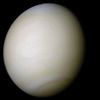
Sun Jupiter Saturn Uranus Neptune Earth Venus Mars Ganymede Titan Mercury Callisto Io Moon Europa Triton Titania Rhea Oberon Iapetus Umbriel Ariel Dione Tethys Vesta Enceladus Miranda Proteus Mimas Hyperion Phoebe Janus Amalthea Epimetheus Prometheus Pandora Mathilde Helene Notes
- † Using equatorial radius and assuming body is spherical
- ‡ Using three radii and assuming body is spheroid
- * Radius is known only very approximately
- R Radius has been determined by various methods, such as optical (Hubble), thermal (Spitzer), or direct imaging via spacecraft
- 9 Unknown radius, generic assumed albedo of 0.09
- $ Well studied asteroid or moon where the dimensions and mass are very well known. Asteroid sizes and masses taken from James Baer's (Bio) personal website.
- M Mass has been determined by perturbation. For asteroids, see James Baer's personal website.
- A Assumed mass
- P Mass calculated assuming Pluto's density of 2.0 g/cm3
- Note: For many of the well-determined moons, radii were taken from the JPL Solar System Dynamics page.
- O Radius has been determined with Asteroid occultation
References
- ^ Mike Brown. "The Dwarf Planets". CalTech. Archived from the original on 2011-02-12. http://www.gps.caltech.edu/~mbrown/dwarfplanets/. Retrieved 2008-09-25.
- ^ D. T. Britt; G. J. Consol-magno SJ; W. J. Merline (2006). "Small Body Density and Porosity: New Data, New Insights". Lunar and Planetary Science XXXVII. http://www.lpi.usra.edu/meetings/lpsc2006/pdf/2214.pdf. Retrieved 2008-12-16.
- ^ a b c d e f g h i j k l m n o p q r s t u v w x y z aa ab ac ad ae af ag ah ai aj ak "Planetary Satellite Physical Parameters". JPL (Solar System Dynamics). 2008-10-24. http://ssd.jpl.nasa.gov/?sat_phys_par. Retrieved 2008-12-16.
- ^ a b Williams, Dr. David R. (2007-11-23). "Uranian Satellite Fact Sheet". NASA (National Space Science Data Center). Archived from the original on 2010-01-18. http://nssdc.gsfc.nasa.gov/planetary/factsheet/uraniansatfact.html. Retrieved 2008-12-12.
- ^ a b c d e f g h i j k l m n o p q r s t u v w x y z aa ab ac ad ae af Mike Brown, How many dwarf planets are there in the outer solar system?[1]
- ^ Densities of those KBOs whose masses are uncertain are assumed to be 2.0 in line with Pluto
- ^ Jacobson, R. A.; Antreasian, P. G.; Bordi, J. J.; Criddle, K. E.; et al. (December 2006). "The gravity field of the saturnian system from satellite observations and spacecraft tracking data". The Astronomical Journal 132 (6): 2520–2526. Bibcode 2006AJ....132.2520J. doi:10.1086/508812.
- ^ "Size, density, albedo and atmosphere limit of dwarf planet Eris from a stellar occultation". European Planetary Science Congress Abstracts 6. 2011. http://meetingorganizer.copernicus.org/EPSC-DPS2011/EPSC-DPS2011-137-8.pdf. Retrieved 2011-09-14.
- ^ M.E. Brown and E.L. Schaller (2007). "The Mass of Dwarf Planet Eris". Science 316 (5831): 1585. Bibcode 2007Sci...316.1585B. doi:10.1126/science.1139415. PMID 17569855. Archived from the original on 2011-02-12. http://www.sciencemag.org/cgi/content/abstract/316/5831/1585.
- ^ Young, Eliot F.; Young, L. A.; Buie, M. (2007). "Pluto's Radius". American Astronomical Society, DPS meeting #39, #62.05; Bulletin of the American Astronomical Society 39: 541. Bibcode 2007DPS....39.6205Y.
- ^ Space Daily - SATURN DAILY DLR Researchers Compile Atlas Of Saturn's Moon Rhea, An Icy Alien World (2010)
- ^ Thomas, P. C.; Burns, J. A.; Helfenstein, P.; Squyres, S.; Veverka, J.; Porco, C.; Turtle, E.; McEwen, A.; Denk, T.; Giese, B.; et al. (2007). "Shapes of the Cronian icy satellites and their significance". Icarus 190 (2): 573–584. Bibcode 2007Icar..190..573T. doi:10.1016/j.icarus.2007.03.012. http://www.sciencedirect.com/science?_ob=ArticleURL&_udi=B6WGF-4NDMNGC-4&_user=10&_coverDate=10%2F31%2F2007&_rdoc=21&_fmt=summary&_orig=browse&_srch=doc-info(%23toc%236821%232007%23998099997%23668725%23FLA%23display%23Volume)&_cdi=6821&_sort=d&_docanchor=&_ct=29&_acct=C000050221&_version=1&_urlVersion=0&_userid=10&md5=8101cb113c75c3b948580ff1b4750474.[dead link]
- ^ a b T.L. Lim, J. Stansberry, T.G. Müller (2010). ""TNOs are Cool": A survey of the trans-Neptunian region III. Thermophysical properties of 90482 Orcus and 136472 Makemake". Astronomy and Astrophysics 518: L148. Bibcode 2010A&A...518L.148L. doi:10.1051/0004-6361/201014701.
- ^ B. Sicardy et al. (2006). "Charon’s size and an upper limit on its atmosphere from a stellar occultation". Nature 439 (7072): 52. Bibcode 2006Natur.439...52S. doi:10.1038/nature04351. PMID 16397493.
- ^ Michael E. Brown. "The largest Kuiper belt objects". In M. Antonietta Barucci, Hermann Boehnhardt, Dale P. Cruikshank (pdf). The Solar System Beyond Neptune. University of Arizona Press. pp. 335–345. ISBN 0-8165-2755-5. http://www.gps.caltech.edu/~mbrown/papers/ps/kbochap.pdf.
- ^ Michael E. Brown; Burgasser, A.J.; Fraser W.C. (2011). "The Surface Composition of Large Kuiper Belt Object 2007 OR10". Mike Brown's Website. arXiv:1108.1418. http://www.gps.caltech.edu/~mbrown/papers/ps/or10.pdf. Retrieved 2011-08-08.
- ^ J. Stansberry, W. Grundy, M. Brown, et al. (2008). "Physical Properties of Kuiper Belt and Centaur Objects: Constraints from Spitzer Space Telescope". The Solar System beyond Neptune (University of Arizona Press). arXiv:astro-ph/0702538. Bibcode 2008ssbn.book..161S.
- ^ a b Pedro Lacerda and David C. Jewitt - Densities of Solar System Objects from their Rotational Lightcurves (2006)- Institute for Astronomy, University of Hawaii, 2680 Woodlawn Drive, Honolulu, HI 96822
- ^ a b c Brown, Michael E.; Fraser, Wesley C. (2010). "Quaoar: A Rock in the Kuiper belt". The Astrophysical Journal 714 (2): 1547. arXiv:1003.5911. Bibcode 2010ApJ...714.1547F. doi:10.1088/0004-637X/714/2/1547.
- ^ a b c d e f g h i j k l m n o p q r s John Stansberry, Will Grundy, Mike Brown, Dale Cruikshank, John Spencer, David Trilling, Jean-Luc Margot (2007). "Physical Properties of Kuiper Belt and Centaur Objects: Constraints from Spitzer Space Telescope". University of Arizona, Lowell Observatory, California Institute of Technology, NASA Ames Research Center, Southwest Research Institute, Cornell University. arXiv:astro-ph/0702538. Bibcode 2008ssbn.book..161S.
- ^ a b c d e f g h i j k l m n o p q r s t u v w x y z aa ab ac ad ae Wm. Robert Johnston (7 August 2010). "List of Known Trans-Neptunian Objects". Johnston's Archive. http://www.johnstonsarchive.net/astro/tnoslist.html. Retrieved 2011-03-03.
- ^ a b c d e f g h i j k l m n o p q r s t u v w x y z Wm. Robert Johnston (22 August 2008). "List of Known Trans-Neptunian Objects". Johnston's Archive. http://www.johnstonsarchive.net/astro/tnoslist.html. Retrieved 2008-12-08.
- ^ Marc W. Buie (2010-06-16 using 19 of 19 observations over 0.98 years (356 days)). "Orbit Fit and Astrometric record for 10KZ39". SwRI (Space Science Department). http://www.boulder.swri.edu/~buie/kbo/astrom/10KZ39.html. Retrieved 2011-08-18.
- ^ "2010 KZ39". IAU Minor Planet Center. http://www.minorplanetcenter.net/db_search/show_object?object_id=2010+KZ39&commit=Show. Retrieved 2011-08-18.
- ^ Densities of those KBOs whose masses are uncertain are assumed to be 2.0 in line with Pluto
- ^ a b Wm. Robert Johnston (7 August 2010). "List of Known Trans-Neptunian Objects". Johnston's Archive. http://www.johnstonsarchive.net/astro/tnoslist.html. Retrieved 2011-04-09.
- ^ Alan Chamberlin. "JPL Small-Body Database Browser". Ssd.jpl.nasa.gov. Archived from the original on 2011-02-12. http://ssd.jpl.nasa.gov/sbdb.cgi?sstr=2;orb=0;cov=0;log=0;cad=0#phys_par. Retrieved 2011-01-04.
- ^ Schmidt, B. E., et al. (2008). "Hubble takes a look at Pallas: Shape, size, and surface" (PDF). 39th Lunar and Planetary Science Conference (Lunar and Planetary Science XXXIX). Held March 10–14, 2008, in League City, Texas. 1391: 2502. http://www.lpi.usra.edu/meetings/lpsc2008/pdf/2502.pdf. Retrieved 2008-08-24.
- ^ Baer, James; Chesley, Steven R. (2008). "Astrometric masses of 21 asteroids, and an integrated asteroid ephemeris" (PDF). Celestial Mechanics and Dynamical Astronomy (Springer Science+Business Media B.V. 2007) 100 (2008): 27–42. Bibcode 2008CeMDA.100...27B. doi:10.1007/s10569-007-9103-8. http://www.springerlink.com/content/h747307j43863228/fulltext.pdf. Retrieved 2008-11-11.
- ^ "Planetary Satellite Physical Parameters". JPL (Solar System Dynamics). 2006-07-13. Archived from the original on 2010-01-18. http://ssd.jpl.nasa.gov/?sat_phys_par. Retrieved 2008-02-09.
- ^ Jim Baer (2008). "Recent Asteroid Mass Determinations". Personal Website. http://home.earthlink.net/~jimbaer1/astmass.txt. Retrieved 2008-12-03.
- ^ Wm. Robert Johnston (26 November 2008). "(119979) 2002 WC19". Johnston's Archive. http://www.johnstonsarchive.net/astro/astmoons/am-119979.html. Retrieved 2009-03-04.
- ^ "JPL definition of Main-belt Asteroid (MBA)". JPL Solar System Dynamics. http://ssd.jpl.nasa.gov/sbdb_help.cgi?class=MBA. Retrieved 2009-03-12.
- ^ a b "List of known trans-Neptunian objects". Johnstonsarchive.net. 2010-08-07. Archived from the original on 2007-06-20. http://www.johnstonsarchive.net/astro/tnoslist.html. Retrieved 2011-01-04.
- ^ Muller, T.G.; Lellouch, E.; Stansberry, J. et al. (2010). ""TNOs are Cool": A survey of the trans-Neptunian region I. Results from the Herschel science demonstration phase (SDP)". Astronomy and Astrophysics 518: L146. Bibcode 2010A&A...518L.146M. doi:10.1051/0004-6361/201014683. Archived from the original on 2011-02-12. http://adsabs.harvard.edu/abs/2010A%26A...518L.146M.
- ^ a b c d e f g h i j k l m n o p q r s t u v w x y z aa ab ac ad ae af ag ah ai aj ak al am an ao ap aq ar as at au av aw ax ay az ba bb bc bd be bf bg bh bi bj bk bl bm bn bo bp bq br bs bt bu bv bw bx by bz ca cb cc cd ce cf cg ch ci cj ck cl cm cn co cp cq cr cs ct cu cv cw cx cy cz da db dc dd de df dg dh di dj dk dl dm dn do dp dq dr ds dt du dv dw dx dy dz ea eb ec ed ee ef eg eh ei ej ek el em en eo ep eq er es et eu ev ew ex ey ez fa fb fc fd fe ff fg fh fi fj fk fl fm fn fo fp fq fr fs ft fu fv Asteroid Data Archive, Archive Planetary Science Institute
- ^ a b c d e f g M. Kaasalainen (2002). "Models of Twenty Asteroids from Photometric Data" (PDF). Icarus 159 (2): 369. Bibcode 2002Icar..159..369K. doi:10.1006/icar.2002.6907. http://www.rni.helsinki.fi/~mjk/IcarPIII.pdf. Retrieved 2009-06-23.
- ^ Clara Moskowitz (2010-06-16). "Scientists size up a bright mini-world". MSNBC. http://www.msnbc.msn.com/id/37735465/ns/technology_and_science-space/. Retrieved 2010-06-16.
- ^ a b c Benecchi, S.D; Noll, K. S.; Grundy, W. M.; Levison, H. F. (2010). "(47171) 1999 TC36, A Transneptunian Triple". Icarus 207 (2): 978–991. arXiv:0912.2074. Bibcode 2010Icar..207..978B. doi:10.1016/j.icarus.2009.12.017.
- ^ Müller, T. G; Blommaert, J. A. D. L. (2004). "65 Cybele in the thermal infrared: Multiple observations and thermophysical analysis". Astronomy and Astrophysics 418 (1): 347–356. arXiv:astro-ph/0401458. Bibcode 2004A&A...418..347M. doi:10.1051/0004-6361:20040025.
- ^ "JPL Small-Body Database Browser: 65 Cybele". 2008-08-10 last obs. Archived from the original on 2010-01-17. http://ssd.jpl.nasa.gov/sbdb.cgi?sstr=65. Retrieved 2008-11-25.
- ^ a b J. Torppa et al. (2003). "Shapes and rotational properties of thirty asteroids from photometric data" (PDF). Icarus 164 (2): 346. Bibcode 2003Icar..164..346T. doi:10.1016/S0019-1035(03)00146-5. http://www.rni.helsinki.fi/~mjk/thirty.pdf.
- ^ Alan Chamberlin. "JPL Small-Body Database Browser". Ssd.jpl.nasa.gov. Archived from the original on 2011-02-12. http://ssd.jpl.nasa.gov/sbdb.cgi?sstr=15%20Eunomia;orb=0;cov=0;log=0;cad=0#phys_par. Retrieved 2011-01-04.
- ^ a b "List of Known Trans-Neptunian Objects". Johnston's Archive. Archived from the original on 2007-06-20. http://www.johnstonsarchive.net/astro/tnoslist.html. Retrieved 2006-12-14.
- ^ "JPL Small-Body Database Browser: 88 Thisbe". 2008-07-04 last obs. http://ssd.jpl.nasa.gov/sbdb.cgi?sstr=88. Retrieved 2008-11-06.
- ^ "2002 KW14". Sphinx.planetwaves.net. Archived from the original on 2011-02-12. http://sphinx.planetwaves.net/2002kw14.htm. Retrieved 2011-01-04.
- ^ Storrs, Alex; Weiss, B.; Zellner, B.; et al. (1998). "Imaging Observations of Asteroids with Hubble Space Telescope". Icarus 137 (2): 260–268. Bibcode 1999Icar..137..260S. doi:10.1006/icar.1999.6047. http://web.media.mit.edu/~win/hstpub.pdf. Retrieved 2005-01-15.[dead link]
- ^ "JPL Small-Body Database Browser: 48 Doris". 2008-06-13 last obs. Archived from the original on 2010-01-17. http://ssd.jpl.nasa.gov/sbdb.cgi?sstr=48. Retrieved 2008-11-10.
- ^ Millis, R.L; Wasserman, Bowell, Franz, Klemola, Dunham (1984). "The diameter of 375 URSULA from its occultation of AG + 39 deg 303". Astronomical Journal 89: 592–596. Bibcode 1984AJ.....89..592M. doi:10.1086/113553.
- ^ Durech., J.; Kaasalainen, M., Marciniak, A.; et al., “Physical models of ten asteroids from an observers' collaboration network”, Astronomy and Astrophysics, Volume 465, Issue 1, April I 2007, pp. 331-337
- ^ Stansberry, Grundy, Brown, Spencer, Trilling, Cruikshank, Luc Margot Physical Properties of Kuiper Belt and Centaur Objects: Constraints from Spitzer Space Telescope (2007) Preprint arXiv
- ^ [Planetary occultations: 2001 results|http://occsec.wellington.net.nz/planet/2001/plnres01.htm#Aurora]
- ^ Fernandes, Yanga R.; Sheppard, Scott S.; Jewitt, David C. (2003). "The albedo distribution of Jovian Trojan asteroids". The Astronomical Journal 126 (3): 1563–1574. Bibcode 2003AJ....126.1563F. doi:10.1086/377015. Archived from the original on 2011-02-12. http://adsabs.harvard.edu/abs/2003AJ....126.1563F.
- ^ "JPL Small-Body Database Browser: 7 Iris". 2009-03-17 last obs. http://ssd.jpl.nasa.gov/sbdb.cgi?sstr=7. Retrieved 2009-03-17.
- ^ Alan Chamberlin. "JPL Small-Body Database Browser". Ssd.jpl.nasa.gov. Archived from the original on 2011-02-12. http://ssd.jpl.nasa.gov/sbdb.cgi?sstr=372%20Palma%20;orb=0;cov=0;log=0;cad=0#phys_par. Retrieved 2011-01-04.
- ^ Davies, J. K.; Tholen, D. J.; Ballantyne, D. R. (1996). "Infrared Observations of Distant Asteroids". Completing the Inventory of the Solar System, Astronomical Society of the Pacific Conference Proceedings 107: 97–105. Bibcode 1996ciss.conf...97D.
- ^ a b c Grundy, W.M.; Stansberry, J.A.; Noll K.S.; Stephens, D.C.; et al. (2007). "The orbit, mass, size, albedo, and density of (65489) Ceto/Phorcys: A tidally-evolved binary Centaur". Icarus 191 (1): 286. arXiv:0704.1523. Bibcode 2007Icar..191..286G. doi:10.1016/j.icarus.2007.04.004.
- ^ Alan Chamberlin. "JPL Small-Body Database Browser". Ssd.jpl.nasa.gov. Archived from the original on 2011-02-12. http://ssd.jpl.nasa.gov/sbdb.cgi?sstr=790%20Pretoria;orb=0;cov=0;log=0;cad=0#phys_par. Retrieved 2011-01-04.
- ^ a b (Note, he assumed geometric albedo of 0.04-->) Sheppard, S. S., Jewitt, D. C., Porco, C.; Jupiter's Outer Satellites and Trojans, in Jupiter: The Planet, Satellites and Magnetosphere, edited by Fran Bagenal, Timothy E. Dowling, William B. McKinnon, Cambridge Planetary Science, Vol. 1, Cambridge, UK: Cambridge University Press, ISBN 978-0-521-81808-7, 2004, pp. 263-280[dead link]
- ^ Emelyanov, N.V.; Archinal, B. A.; A’hearn, M. F.; et al. (2005). "The mass of Himalia from the perturbations on other satellites". Astronomy and Astrophysics 438 (3): L33–L36. Bibcode 2005A&A...438L..33E. doi:10.1051/0004-6361:200500143.
- ^ http://www.cfa.harvard.edu/iau/lists/NumberedMPs.txt Archived 12 February 2011 at WebCite
- ^ Thomas, P.C.; Burns, J.A.; Rossier, L.; et.al. (1998). "The Small Inner Satellites of Jupiter". Icarus 135 (1): 360–371. Bibcode 1998Icar..135..360T. doi:10.1006/icar.1998.5976. Archived from the original on 2011-02-12. http://adsabs.harvard.edu/abs/1998Icar..135..360T.
- ^ Anderson, J.D.; Johnson, T.V.; Shubert, G.; et.al. (2005). "Amalthea’s Density Is Less Than That of Water". Science 308 (5726): 1291–1293. Bibcode 2005Sci...308.1291A. doi:10.1126/science.1110422. PMID 15919987. Archived from the original on 2007-06-28. http://adsabs.harvard.edu/abs/2005Sci...308.1291A.
- ^ a b Descamps, P.; Marchis, F.; Pollock, J. et al. (2008). "New determination of the size and bulk density of the binary asteroid 22 Kalliope from observations of mutual eclipses". Icarus 196 (2): 578–600. arXiv:0710.1471. Bibcode 2008Icar..196..578D. doi:10.1016/j.icarus.2008.03.014. Archived from the original on 2011-02-12. http://adsabs.harvard.edu/abs/2008Icar..196..578D.
- ^ Alan Chamberlin. "JPL Small-Body Database Browser". Ssd.jpl.nasa.gov. Archived from the original on 2011-02-12. http://ssd.jpl.nasa.gov/sbdb.cgi?sstr=386%20Siegena;orb=0;cov=0;log=0;cad=0#phys_par. Retrieved 2011-01-04.
- ^ JPL Small-Body Database Browser on 20461 Dioretsa
- ^ Alan Chamberlin. "JPL Small-Body Database Browser". Ssd.jpl.nasa.gov. Archived from the original on 2007-06-23. http://ssd.jpl.nasa.gov/sbdb.cgi. Retrieved 2011-01-04.
- ^ "JPL Small-Body Database Browser: 14 Irene". 2008-04-14 last obs. http://ssd.jpl.nasa.gov/sbdb.cgi?sstr=14. Retrieved 2008-11-27.
- ^ "Dwarf planet Eris bigger than Pluto - Astronomy Magazine". Astronomy.com. 2007-06-14. Archived from the original on 2011-02-12. http://www.astronomy.com/asy/default.aspx?c=a&id=5673. Retrieved 2011-01-04.
- ^ Alan Chamberlin. "JPL Small-Body Database Browser". Ssd.jpl.nasa.gov. Archived from the original on 2011-02-12. http://ssd.jpl.nasa.gov/sbdb.cgi?sstr=1172%20;orb=0;cov=0;log=0;cad=0#phys_par. Retrieved 2011-01-04.
- ^ JPL 508 Archived 12 February 2011 at WebCite
- ^ Johnston's Archive about (66652) Borasisi and Pabu
- ^ "(212) Médée." Wikipédia, l'encyclopédie libre. 16 jan 2009, 21:16 UTC. 13 mar 2009, 00:01 <http://fr.wikipedia.org/w/index.php?title=(212)_M%C3%A9d%C3%A9e&oldid=37119259>.
- ^ "JPL Small-Body Database Browser: 92 Undina". Archived from the original on 2010-01-17. http://ssd.jpl.nasa.gov/sbdb.cgi?sstr=92. Retrieved 2010-10-09.
- ^ Michalak, G. (2001). "Determination of asteroid masses". Astronomy & Astrophysics 374 (2): 703–711. Bibcode 2001A&A...374..703M. doi:10.1051/0004-6361:20010731. http://www.aanda.org/index.php?option=article&access=standard&Itemid=129&url=/articles/aa/abs/2001/29/aa10228/aa10228.html. Retrieved 2008-11-10.
- ^ Bange, J.F; A. Bec-Borsenberger (1997). DETERMINATION OF THE MASSES OF MINOR PLANETS. p. 169. http://www.rssd.esa.int/Hipparcos/venice-proc/poster02_22.pdf. Retrieved 2008-11-10.
- ^ Alan Chamberlin. "JPL Small-Body Database Browser". Ssd.jpl.nasa.gov. Archived from the original on 2011-02-12. http://ssd.jpl.nasa.gov/sbdb.cgi?sstr=127;orb=0;cov=0;log=0;cad=0#phys_par. Retrieved 2011-01-04.
- ^ Spitale, J. N.; et al. (2006). "The orbits of Saturn's small satellites derived from combined historic and Cassini imaging observations". The Astronomical Journal 132 (2): 692–710. Bibcode 2006AJ....132..692S. doi:10.1086/505206. Archived from the original on 2011-02-12. http://www.iop.org/EJ/article/1538-3881/132/2/692/205235.html.
- ^ Alan Chamberlin. "JPL Small-Body Database Browser". Ssd.jpl.nasa.gov. Archived from the original on 2011-02-12. http://ssd.jpl.nasa.gov/sbdb.cgi?sstr=129;orb=0;cov=0;log=0;cad=0#phys_par. Retrieved 2011-01-04.
- ^ Jonathan Amos - Asteroid Lutetia has thick blanket of debris (4 October 2010) - BBC News Archived 12 February 2011 at WebCite
- ^ average of values taken from: H. A. Weaver; S. A. Stern, M. J. Mutchler, A. J. Steffl, M. W. Buie, W. J. Merline, J. R. Spencer, E. F. Young and L. A. Young (23 February 2006). "Discovery of two new satellites of Pluto". Nature 439 (7079): 943–945. arXiv:astro-ph/0601018. Bibcode 2006Natur.439..943W. doi:10.1038/nature04547. PMID 16495991.
- ^ "IRAS Minor Planet Survey". Archived from the original on 2005-12-11. http://web.archive.org/web/20051211134758/http://www.psi.edu/pds/archive/simps.html.
- ^ a b "(90) Antiope and S/2000 (90) 1". Johnstonsarchive.net. Archived from the original on 2011-02-12. http://www.johnstonsarchive.net/astro/astmoons/am-00090.html. Retrieved 2011-01-04.
- ^ a b c Planetary Satellite Physical Parameters - NASA - 2011
- ^ "JPL Small-Body Database Browser: 60558 Echeclus (2000 EC98)". 2008-05-07 last obs. http://ssd.jpl.nasa.gov/sbdb.cgi?sstr=60558. Retrieved 2008-09-09.
- ^ Tedesco et al. (2004). "Supplemental IRAS Minor Planet Survey (SIMPS)". IRAS-A-FPA-3-RDR-IMPS-V6.0. Planetary Data System. Archived from the original on 2010-01-17. http://www.webcitation.org/5mqp8r4gD. Retrieved December 31, 2008.
- ^ "JPL Small-Body Database Browser: 84 Klio". 2008-03-30 last obs. http://ssd.jpl.nasa.gov/sbdb.cgi?sstr=84. Retrieved 2008-11-06.
- ^ Grundy, W. M; Noll, K. S.; Stephens, D. C. (2005). "Diverse albedos of small trans-neptunian objects". Icarus 176 (1): 184–191. arXiv:astro-ph/0502229. Bibcode 2005Icar..176..184G. doi:10.1016/j.icarus.2005.01.007. (Preprint on arXiv.)
- ^ Barucci, M. A., de Bergh, C., Cuby, J.-G., Le Bras, A., Schmitt, B., & Romon, J. (2000). "Infrared spectroscopy of the Centaur 8405 Asbolus: first observations at ESO-VLT". Astronomy and Astrophysics 357: L53–L56. Bibcode 2000A&A...357L..53B. Archived from the original on 2011-02-12. http://adsabs.harvard.edu/full/2000A&A...357L..53B.
- ^ Alan Chamberlin. "JPL Small-Body Database Browser". Ssd.jpl.nasa.gov. Archived from the original on 2011-02-12. http://ssd.jpl.nasa.gov/sbdb.cgi?sstr=108%20Hecuba;orb=0;cov=0;log=0;cad=0#phys_par. Retrieved 2011-01-04.
- ^ "JPL Small-Body Database Browser: C/1995 O1 (Hale-Bopp)". 2007-10-22 last obs. http://ssd.jpl.nasa.gov/sbdb.cgi?sstr=Hale-Bopp. Retrieved 2008-12-05.
- ^ Lionel Wilson and Klaus Keil (1991). "Explosive Eruptions on Asteroids: The Missing Basalts on the Aubrite Parent Body". Abstracts of the Lunar and Planetary Science Conference 22: 1515. Bibcode 1991LPI....22.1515W.
- ^ "2008-07-16 Tracking News". Hohmanntransfer.com. Archived from the original on 2011-02-12. http://www.hohmanntransfer.com/mn/08/08198_0716.htm. Retrieved 2011-01-04.
- ^ Pierre Vingerhoets and Jan Van Gestel (2004-01-31). "E.A.O.N. : (4348) Poulydamas". European Asteroidal Occultation Network (E.A.O.N.). Archived from the original on 2011-02-12. http://www.aula.com/EAON/Files/2004.0131-4348.gif. Retrieved 2010-05-31.
- ^ Thomas, P.C.; Burns, J.A.; Rossier, L.; et al. (1998). "The Small Inner Satellites of Jupiter". ICARUS 135 (1): 360–371. Bibcode 1998Icar..135..360T. doi:10.1006/icar.1998.5976. Archived from the original on 2011-02-12. http://adsabs.harvard.edu/abs/1998Icar..135..360T.
- ^ Britt et al. 2002, p. 486
- ^ Karkoschka, Erich (2001). "Voyager's Eleventh Discovery of a Satellite of Uranus and Photometry and the First Size Measurements of Nine Satellites". Icarus 151 (1): 69–77. Bibcode 2001Icar..151...69K. doi:10.1006/icar.2001.6597.
- ^ a b c Porco, C. C.; et al. (2007). "Saturn's Small Inner Satellites: Clues to Their Origins". Science 318 (5856): 1602–1607. Bibcode 2007Sci...318.1602P. doi:10.1126/science.1143977. PMID 18063794. Archived from the original on 2011-02-12. http://adsabs.harvard.edu/abs/2007Sci...318.1602P.
- ^ F. Marchis et al. (2003). "A three-dimensional solution for the orbit of the asteroidal satellite of 22 Kalliope". Icarus 165 (1): 112. Bibcode 2003Icar..165..112M. doi:10.1016/S0019-1035(03)00195-7. Archived from the original on 2011-02-12. http://adsabs.harvard.edu/abs/2008Icar..196..578D.
- ^ Porco, C.C. et al. (2006). "Physical Characteristics and Possible Accretionary Origins for Saturn's Small Satellites". Bulletin of the American Astronomical Society 37: 768. Archived from the original on 2007-07-27. http://www.lpi.usra.edu/meetings/lpsc2006/pdf/2289.pdf.
- ^ IOTA/IOTA-ES occultation update for (2000) Herschel
- ^ [JPL Small-Body Database Browser : 2000 Herschel]
- ^ "JPL Small-Body Database Browser: 65407 (2002 RP120)". Archived from the original on 2011-02-12. http://ssd.jpl.nasa.gov/sbdb.cgi?sstr=2002RP120. Retrieved 2008-02-06.
- ^ "The Shape of Gaspra : Galileo's observations of 951 Gaspra". Cat.inist.fr. Archived from the original on 2011-02-12. http://cat.inist.fr/?aModele=afficheN&cpsidt=3984962. Retrieved 2011-01-04.
- ^ a b F. Marchis et al. (2006). "Shape, size and multiplicity of main-belt asteroids I. Keck Adaptive Optics survey". Icarus 185 (1): 39. Bibcode 2006Icar..185...39M. doi:10.1016/j.icarus.2006.06.001. PMC 2600456. PMID 19081813. Archived from the original on 2011-02-12. http://adsabs.harvard.edu/cgi-bin/nph-bib_query?bibcode=2006Icar..185...39M&db_key=AST&data_type=HTML&format=&high=444b66a47d32271.
- ^ 11 km average diameter 2004 study NASA JPL Small-Body Database Browser on 1P
- ^ Using the volume of an ellipsoid of 15x8x8km * an assumed rubble pile density of 0.6 g/cm3 yields a mass (m=d*v) of ~3.02E+14 kg
- ^ Scott S. Sheppard. "Uranus' Known Satellites". Carnegie Institution (Department of Terrestrial Magnetism). http://www.dtm.ciw.edu/users/sheppard/satellites/urasatdata.html. Retrieved 2011-01-22.
- ^ Porco, C. C.; et al. (2007). "Saturn's Small Inner Satellites: Clues to Their Origins". Science 318 (5856): 1602–1607. Bibcode 2007Sci...318.1602P. doi:10.1126/science.1143977. PMID 18063794. Archived from the original on 2011-02-12. http://adsabs.harvard.edu/abs/2007Sci...318.1602P.
- ^ "Comet 9P/Tempel 1". The Planetary Society. Archived from the original on 2011-02-12. http://www.planetary.org/explore/topics/asteroids_and_comets/tempel1.html. Retrieved 2008-12-16.
- ^ "JPL Small-Body Database Browser: 9P/Tempel 1". 2008-10-25 last obs. Archived from the original on 2011-02-12. http://ssd.jpl.nasa.gov/sbdb.cgi?sstr=9P. Retrieved 2008-12-16.
- ^ Cassini Equinox Mission: Thrym (accessed October 2010) Archived 12 February 2011 at WebCite
- ^ Alan Chamberlin. "JPL Small-Body Database Browser". Ssd.jpl.nasa.gov. Archived from the original on 2011-02-12. http://ssd.jpl.nasa.gov/sbdb.cgi?sstr=Toutatis;orb=0;cov=0;log=0;cad=0#phys_par. Retrieved 2011-01-04.
- ^ "Jupiter, in Astronomy"; The Columbia Encyclopedia, Sixth Edition, 2004. 52323 pgs.
- ^ H. U. Keller, et all - E-Type Asteroid (2867) Steins as Imaged by OSIRIS on Board Rosetta - Science 8 January 2010: Vol. 327. no. 5962, pp. 190 - 193 DOI: 10.1126/science.1179559[dead link]
- ^ 4.8 km diameter NASA JPL Small-Body Database Browser on 19P/Borrelly
- ^ NASA JPL Small-Body Database Browser on 2P/Encke
- ^ NASA JPL Small-Body Database Browser on C/1996 B2
- ^ "Comet Hyakutake Home Page (JPL)". .jpl.nasa.gov. Archived from the original on 2011-02-12. http://www2.jpl.nasa.gov/comet/hyakutake/index.html. Retrieved 2011-01-04.
- ^ Alan Chamberlin. "JPL Small-Body Database Browser". Ssd.jpl.nasa.gov. Archived from the original on 2011-02-12. http://ssd.jpl.nasa.gov/sbdb.cgi?ID=c00081_0. Retrieved 2011-01-04.
- ^ Source: Porco et al. 2005 Archived 12 February 2011 at WebCite
- ^ "Cloudbait Observatory Gallery - Comet Holmes". Cloudbait.com. Archived from the original on 2011-02-12. http://www.cloudbait.com/gallery/comet/holmes.html. Retrieved 2011-01-04.
- ^ Alan Chamberlin. "JPL Small-Body Database Browser". Ssd.jpl.nasa.gov. Archived from the original on 2011-02-12. http://ssd.jpl.nasa.gov/sbdb.cgi?sstr=4055%20Magellan;orb=0;cov=0;log=0;cad=0#phys_par. Retrieved 2011-01-04.
- ^ NASA JPL Small-Body Database Browser on 6178 (1986 DA)
- ^ a b Roman Numerals
- ^ Tedesco, Edward; Metcalfe, Leo (April 4, 2002). "New study reveals twice as many asteroids as previously believed" (Press release). European Space Agency. http://www.spaceref.com/news/viewpr.html?pid=7925. Retrieved 2009-10-20.
- ^ Minor Planet No. 100,000 Named for Space Age 50th Anniversary (2007) - Space Ref, Quote: "..about a mile in size"
- ^ [JPL Small-Body Database Browser: 100000 Astronautica]
- ^ Alan Chamberlin. "JPL Small-Body Database Browser". Ssd.jpl.nasa.gov. Archived from the original on 2011-02-12. http://ssd.jpl.nasa.gov/sbdb.cgi?sstr=4769%20Castalia;orb=0;cov=0;log=0;cad=0#phys_par. Retrieved 2011-01-04.
- ^ "(4769) Castalia." Wikipédia, l'encyclopédie libre. 20 jan 2010, 16:37 UTC. 11 oct 2010, 16:48 <http://fr.wikipedia.org/w/index.php?title=(4769)_Castalia&oldid=49048108>
- ^ 3000 x 10^9 kg
- ^ a b Lisse, C. M.; Fernandez; Reach; Bauer; A'Hearn; Farnham; et al. (2009). "Spitzer Space Telescope Observations of the Nucleus of Comet 103P/Hartley 2". Publications of the Astronomical Society of the Pacific 121: 968–975. Bibcode 2009PASP..121..968L. doi:10.1086/605546. http://www.jstor.org/stable/10.1086/605546.
- ^ "JPL Small-Body Database Browser: 14827 Hypnos (1986 JK)". Archived from the original on 2011-02-12. http://ssd.jpl.nasa.gov/sbdb.cgi?sstr=Hypnos. Retrieved 2008-02-08.
- ^ Whitman, Kathryn; Alessandro Morbidelli and Robert Jedicke (2006). The Size-Frequency Distribution of Dormant Jupiter Family Comets. arXiv:astro-ph/0603106. Bibcode 2006Icar..183..101W. doi:10.1016/j.icarus.2006.02.016.
- ^ 2062 Aten (this version)[dead link]
- ^ Alan Chamberlin. "JPL Small-Body Database Browser". Ssd.jpl.nasa.gov. Archived from the original on 2011-02-12. http://ssd.jpl.nasa.gov/sbdb.cgi#top. Retrieved 2011-01-04.
- ^ a b c Based on an assumed density of 2.6 g/cm3 as given at the NASA NEO impact risk page http://neo.jpl.nasa.gov/risk/index.html Archived 12 February 2011 at WebCite
- ^ BBC - Giant asteroid passes near Earth - 9 November 2011
- ^ Alan Chamberlin. "JPL Small-Body Database Browser". Ssd.jpl.nasa.gov. Archived from the original on 2011-02-12. http://ssd.jpl.nasa.gov/sbdb.cgi?sstr=4660%20Nereus;orb=0;cov=0;log=0;cad=0#phys_par. Retrieved 2011-01-04.
- ^ "NASA Scientists Get First Images of Earth Flyby Asteroid". NASA/JPL. 2008-01-25. Archived from the original on 2011-02-12. http://www.jpl.nasa.gov/news/news.cfm?release=2008-014. Retrieved 2008-01-26.
- ^ [http://neo.jpl.nasa.gov/risk/1994wr12.html NASA - 1994 WR12 Earth Impact Risk Summary - 2011]
- ^ a b c BBC News - Record spin for newfound asteroid (2008) Archived 12 February 2011 at WebCite
- ^ Alan Chamberlin. "JPL Small-Body Database Browser". Ssd.jpl.nasa.gov. Archived from the original on 2011-02-12. http://ssd.jpl.nasa.gov/sbdb.cgi?sstr=1998%20KY26;orb=0;cov=0;log=0;cad=0#phys_par. Retrieved 2011-01-04.
Further reading
- NASA Planetary Data System (PDS)
- Asteroids with Satellites
- Minor Planet discovery circumstances
- Supplemental IRAS Minor Planet Survey (SIMPS) and IRAS Minor Planet Survey (IMPS)
- SIMPS & IMPS (V6, additional, from here)
- Asteroid Data Archive (dead link) Archive Planetary Science Institute
External links
- Planetary fact sheets
- Asteroid fact sheet
- All (known) Bodies in the Solar System Larger than 200 Miles in Diameter - in an image, put side-by-side.
- Size comparison of asteroids and comets visited by space probe (Parent article of image at The Planetary Society)
- Scaled Solar System montage at TPS Blog
The Solar System 
- Astronomical object
- Star
- Planet
- Dwarf planet
- Small Solar System body
- Planetary system
- List of Solar System objects
- List of Solar System objects by size
- List of minor planets
- Solar System Portal
Categories:- Lists of Solar System objects
Wikimedia Foundation. 2010.



